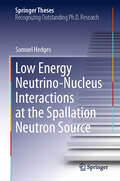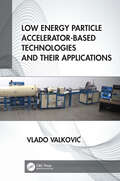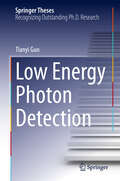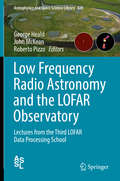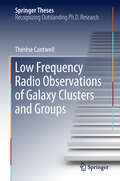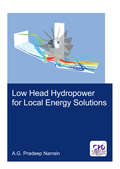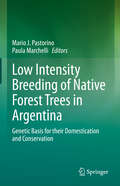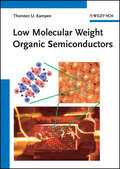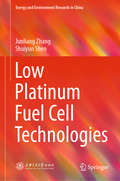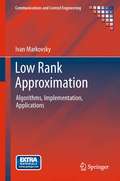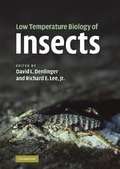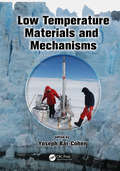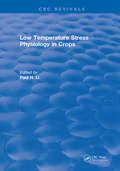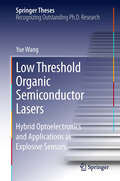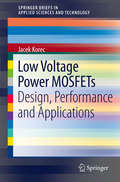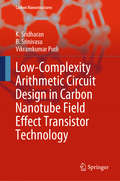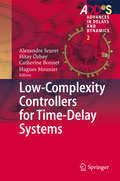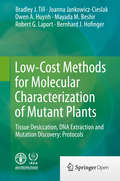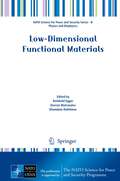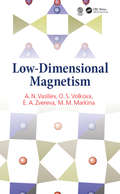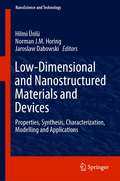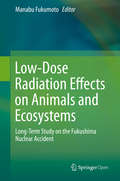- Table View
- List View
Low Energy Neutrino-Nucleus Interactions at the Spallation Neutron Source (Springer Theses)
by Samuel HedgesThis thesis highlights the development and analysis of multiple neutrino detectors deployed to the Spallation Neutron Source (SNS) at Oak Ridge National Laboratory as part of the COHERENT experiment. It includes a preliminary measurement of the neutrino-induced neutron cross section on lead, and analysis that led to the first inclusive electron-neutrino charged-current measurement on iodine. These results add to the small number of inelastic neutrino-nucleus cross sections measured in this energy range, which are useful for understanding supernova and solar neutrino detection sensitivity. Additionally, it discusses preliminary work for and design of COHERENT’s ton-scale NaI coherent elastic neutrino-nucleus scattering (CEvNS) detector, currently being deployed to the SNS. Finally, it includes information on a campaign to measure the nuclear recoil quenching factor of NaI using multiple crystals, attempting to resolve inconsistencies with existing measurements.
Low Energy Particle Accelerator-Based Technologies and Their Applications
by Vlado ValkovićLow Energy Particle Accelerator-Based Technologies and Their Applications describes types of low energy accelerators, presents some of the main manufacturers, illustrates some of the accelerator laboratories around the globe and shows examples of successful transfers of accelerators to needed laboratories. Key Features: Presents new trends and the state of the art in a field that's growing Provides an overview of numerous applications of such accelerators in medicine, industry, earth sciences, nuclear non-proliferation and oil Fills a gap, with the author drawing on his own experiences with transporting such relatively large machines from one lab to the other that require a tremendous amount of planning, technical and engineering efforts This is an essential reference for advanced students as well as for physicists, engineers and practitioners in accelerator science. About the Author Dr. Vladivoj (Vlado) Valković, a retired professor of physics, is a fellow of the American Physical Society and Institute of Physics (London). He has authored 22 books (from Trace Elements, Taylor & Francis, 1975, to Radioactivity in the Environment, Elsevier, 1st Edition 2001, 2nd Edition 2019), and more than 400 scientific and technical papers in the research areas of nuclear physics, applications of nuclear techniques to trace element analysis in biology, medicine and environmental research. He has lifelong experience in the study of nuclear reactions induced by 14 MeV neutrons. This research has been done through coordination and works on many national and international projects, including US-Croatia bilateral, NATO, IAEA, EU-FP5, FP6 and FP7 projects. Cover photo credit: 3SDH 1 MV Pelletron system with RF source and analysis endstation designed with the intended purpose of aiding in fusion research. It is capable of Ion Beam Analysis (IBA) techniques such as RBS, ERD, PIXE and NRA. Further detectors could be added to the endstation to allow for other techniques. Installed in Japan in 2014. Courtesy of National Electrostatics Corp.
Low Energy Photon Detection (Springer Theses)
by Tianyi GuoThis thesis showcases innovative new approaches aimed at advancing the next generation of long wave infrared (LWIR) light detectors and cameras. Detecting LWIR light at room temperature has posed a persistent challenge due to the low energy of photons. The pursuit of an affordable, high-performance LWIR camera capable of room temperature detection has spanned several decades. The two approaches detailed within are designed to offer high detectivity, swift response times, and room temperature operation. The first involves harnessing the Dirac plasmon and the Seebeck effect in graphene to create a photo-thermoelectric detector. The second entails the use of an oscillating circuit integrated with phase change materials and the modulation of frequency induced by infrared illumination to achieve LWIR detection. Finally, the graphene-based detectors are integrated with readout circuits to enable the development of a dense pixel focal plane which has strong potential for commercialization. The journey from novel material to device to functional camera presented here is essential reading for researchers in the field of photon detection.
Low Frequency Radio Astronomy and the LOFAR Observatory: Lectures from the Third LOFAR Data Processing School (Astrophysics and Space Science Library #426)
by George Heald John McKean Roberto PizzoThis book presents lecture materials from the Third LOFAR Data School, transformed into a coherent and complete reference book describing the LOFAR design, along with descriptions of primary science cases, data processing techniques, and recipes for data handling. Together with hands-on exercises the chapters, based on the lecture notes, teach fundamentals and practical knowledge. LOFAR is a new and innovative radio telescope operating at low radio frequencies (10-250 MHz) and is the first of a new generation of radio interferometers that are leading the way to the ambitious Square Kilometre Array (SKA) to be built in the next decade. This unique reference guide serves as a primary information source for research groups around the world that seek to make the most of LOFAR data, as well as those who will push these topics forward to the next level with the design, construction, and realization of the SKA. This book will also be useful as supplementary reading material for any astrophysics overview or astrophysical techniques course, particularly those geared towards radio astronomy (and radio astronomy techniques).
Low Frequency Radio Observations of Galaxy Clusters and Groups (Springer Theses)
by Thérèse CantwellThis book uses new data from the very low radio frequency telescope LOFAR to analyse the magnetic structure in the giant radio galaxy NGC6251. This analysis reveals that the magnetic field strength in the locality of this giant radio galaxy is an order of magnitude lower than in other comparable systems. Due to the observational limitations associated with capturing such huge astrophysical structures, giant radio galaxies are historically a poorly sampled population of objects; however, their preferential placement in the more rarefied regions of the cosmic web makes them a uniquely important probe of large-scale structures. In particular, the polarisation of the radio emissions from giant radio galaxies is one of the few tools available to us that can be used to measure magnetic fields in regions where the strength of those fields is a key differentiator for competing models of the origin of cosmic magnetism. Low frequency polarisation data are crucial for detailed analyses of magnetic structure, but they are also the most challenging type of observational data to work with. This book presents a beautifully coupled description of the technical and scientific analysis required to extract valuable information from such data and, as the new generation of low frequency radio telescopes reveals the larger population of giant radio galaxies, it offers a significant resource for future analyses.
Low Head Hydropower for Local Energy Solutions (IHE Delft PhD Thesis Series)
by Pradeep NarrainThe role of small hydropower is becoming increasingly important on a global level. Increasing energy demand and environmental awareness has further triggered research and development into sustainable low-cost technologies. In developing countries, particularly in rural areas, the possibility of local power generation could considerably improve living conditions. With this in mind, the development of a next generation low-head hydropower machines was subject of investigation in the EU-project HYLOW. Being part of the research lines of that project, this thesis presents a numerical modelling approach to improve the design of machines like water wheels for increased hydraulic efficiency. Nowadays, Computational Fluid Dynamics (CFD) enables numerical models to be quite accurate and incorporate physical complexities like free surfaces and rotating machines. The results of the CFD simulations carried out in this research show that a change in blade geometry can result in higher torque levels, thereby increasing performance. Numerical simulations also enabled to determine the optimal wheel-width to channel-width ratio and further improve performance by modifying the channel bed conditions upstream and downstream of the water wheel. With a power rating in the low kilowatt range, low-head hydropower machines like optimised water wheels seem to have a clear potential for small-scale energy generation, thereby contributing to achieving the Sustainable Development Goals by providing local energy solutions.
Low Intensity Breeding of Native Forest Trees in Argentina: Genetic Basis for their Domestication and Conservation
by Mario J. Pastorino Paula MarchelliGlobal climate change requires the development of programs that consider the active restoration of degraded forests and the use of native trees in afforestation to preserve the natural environment. International commitments like the UN REDD program, the Montréal Process and the Convention on Biological Diversity call for the breeding of species rarely contemplated by large industrial companies. Low-intensity breeding is the most rational strategy for those species: simple but robust, and not dependent on continuously increasing funding, and therefore effective even with a relatively small budget. It commonly focuses on high genetic diversity rather than improving economic traits and adaptability rather than productivity. Controlled crosses with full pedigrees typical of high-intensity breeding are replaced by open pollination. This book presents state-of-the-art breeding strategies from the last two decades for several forest tree species of prime importance in the natural forests of Argentina. They are distributed in the three main forestry ecoregions of the country: the subtropical dry forest (Chaco), the subtropical rain forests (Yungas and Alto Paraná rainforests) and the temperate forests of Patagonia. The book also discusses the genetic patterns of the selected species defined using genetic markers together with the analysis of the variation in quantitative traits. Further, it examines the crucial features of their reproductive biology, such as the mating system and gene flow and describes the current breeding programs. Lastly, it presents the latest developments in genetic resources and their emerging applications, concluding with some reflections and perspectives related to the conditioning imposed by climate change.
Low Molecular Weight Organic Semiconductors
by Thorsten U. KampenThis up-to-date reference for students and researchers in the field is the first systematic treatment on the property measurements of organic semiconductor materials. Following an introduction, the book goes on to treat the structural analysis of thin films and spectroscopy of electronic states. Subsequent sections deal with optical spectroscopy and charge transport. An invaluable source for understanding, handling and applying this key type of material for physicists, materials scientists, graduate students, and analytical laboratories.
Low Platinum Fuel Cell Technologies (Energy and Environment Research in China)
by Junliang Zhang Shuiyun ShenThis book introduces readers to the fundamental physics and chemistry of the proton exchange membrane fuel cell (PEMFC), followed by discussions on recent advances in low platinum electrocatalysis and related catalyst development for PEMFC (the book’s primary focus), methods of membrane electrode assembly (MEA) fabrication for low platinum catalysts, and durability issues in connection with MEA. While energy and environmental issues are becoming the two main subjects in global sustainable development, the proton exchange membrane fuel cell (PEMFC), a clean and efficient new energy technology, has attracted more and more attention in recent years The major hurdle for more extensive applications of the PEMFC, especially for the automotive sector, is the high platinum loading requirement. Readers will gain a comprehensive understanding of the fundamentals and methods of low platinum PEMFC. This book is intended for researchers, engineers and graduate students in the fields of new energy technology, the fuel cell vehicle industry and fuel cell design.
Low Rank Approximation
by Ivan MarkovskyData Approximation by Low-complexity Models details the theory, algorithms, and applications of structured low-rank approximation. Efficient local optimization methods and effective suboptimal convex relaxations for Toeplitz, Hankel, and Sylvester structured problems are presented. Much of the text is devoted to describing the applications of the theory including: system and control theory; signal processing; computer algebra for approximate factorization and common divisor computation; computer vision for image deblurring and segmentation; machine learning for information retrieval and clustering; bioinformatics for microarray data analysis; chemometrics for multivariate calibration; and psychometrics for factor analysis. Software implementation of the methods is given, making the theory directly applicable in practice. All numerical examples are included in demonstration files giving hands-on experience and exercises and MATLAB® examples assist in the assimilation of the theory.
Low Temperature Biology of Insects
by David L. Denlinger Richard E. Lee Jr.Low temperature is a major environmental constraint impacting the geographic distribution and seasonal activity patterns of insects. Written for academic researchers in environmental physiology and entomology, this book explores the physiological and molecular mechanisms that enable insects to cope with a cold environment and places these findings into an evolutionary and ecological context. An introductory chapter provides a primer on insect cold tolerance and subsequent chapters in the first section discuss the organismal, cellular and molecular responses that allow insects to survive in the cold despite their, at best, limited ability to regulate their own body temperature. The second section, highlighting the evolutionary and macrophysiological responses to low temperature, is especially relevant for understanding the impact of global climate change on insect systems. A final section translates the knowledge gained from the rest of the book into practical applications including cryopreservation and the augmentation of pest management strategies.
Low Temperature Materials and Mechanisms
by Yoseph Bar CohenThis book addresses the growing interest in low temperature technologies. Since the subject of low temperature materials and mechanisms is multidisciplinary, the chapters reflect the broadest possible perspective of the field. Leading experts in the specific subject area address the various related science and engineering chemistry, material science, electrical engineering, mechanical engineering, metallurgy, and physics.
Low Temperature Plasma Technology: Methods and Applications
by Paul K. Chu XinPei LuWritten by a team of pioneering scientists from around the world, Low Temperature Plasma Technology: Methods and Applications brings together recent technological advances and research in the rapidly growing field of low temperature plasmas. The book provides a comprehensive overview of related phenomena such as plasma bullets, plasma penetration i
Low Temperature Stress Physiology in Crops
by P.H. LiThe importance of low temperature stress physiology research has become increasingly apparent in agriculture for productions of food, fibre and ornamental plants. This volume consists of two parts, there are a total of 14 chapters including 6 chapters dealing with cold accumulation related topics, 6 dealing with freeze stress and 2 related to ethylene production and mefluidide protection.
Low Threshold Organic Semiconductor Lasers
by Yue WangThis thesis focuses on two areas - the development of miniature plastic lasers that can be powered by LEDs, and the application of these lasers as highly sensitive sensors for vapours of nitroaromatic explosives (e. g. TNT). Polymer lasers are extremely compact visible lasers; the research described in the thesis is groundbreaking, driving forward the technology and physical understanding to allow these lasers to be routinely pumped by a single high-power LED. A notable advance in the work is the demonstration of nanoimprinted polymer lasers, which exhibit the world's lowest pump threshold densities by two orders of magnitude. The thesis also advances the application of these compact, novel lasers as highly sensitive detectors of explosive vapours, demonstrating that rapid detection can be achieved when microporous polymers are used. This work also demonstrates a prototype CMOS-based microsystem sensor for explosive vapours, exploiting a new detection approach.
Low Voltage Electron Microscopy
by David C. Bell Natasha ErdmanPart of the Wiley-Royal Microscopical Society Series, this book discusses the rapidly developing cutting-edge field of low-voltage microscopy, a field that has only recently emerged due to the rapid developments in the electron optics design and image processing.It serves as a guide for current and new microscopists and materials scientists who are active in the field of nanotechnology, and presents applications in nanotechnology and research of surface-related phenomena, allowing researches to observe materials as never before.
Low Voltage Power MOSFETs
by Jacek KorecLow Voltage Power MOSFETs focuses on the design of low voltage power MOSFETs and the relation between the device structure and the performance of a power MOSFET used as a switch in power management applications. This SpringerBriefs close the gap between detailed engineering reference books and the numerous technical papers on the subject of power MOSFETs. The material presented covers low voltage applications extending from battery operated portable electronics, through point of load converters, internet infrastructure, automotive applications, to personal computers and server computers. The issues treated in this volume are explained qualitatively using schematic illustrations, making the discussion easy to follow for all prospective readers.
Low-Complexity Arithmetic Circuit Design in Carbon Nanotube Field Effect Transistor Technology (Carbon Nanostructures)
by K. Sridharan Vikramkumar Pudi B. SrinivasuThis book introduces readers to the emerging carbon nanotube field-effect transistor (CNTFET) technology, and examines the problem of designing efficient arithmetic circuits in CNTFET technology. Observing that CNTFETs make it possible to achieve two distinct threshold voltages merely by altering the diameter of the carbon nanotube used, the book begins by discussing the design of basic ternary logic elements. It then examines efficient CNTFET-based design of single and multiple ternary digit adders by judicious choice of unary operators in ternary logic, as well as the design of a ternary multiplier in CNTFET technology, and presents detailed simulation results in HSPICE. Lastly, the book outlines a procedure for automating the synthesis process and provides sample code in Python.
Low-Complexity Controllers for Time-Delay Systems
by Hitay Özbay Alexandre Seuret Catherine Bonnet Hugues MounierThis volume in the newly established series Advances in Delays and Dynamics (ADD@S) provides a collection of recent results on the design and analysis of Low Complexity Controllers for Time Delay Systems. A widely used indirect method to obtain low order controllers for time delay systems is to design a controller for the reduced order model of the plant. In the dual indirect approach, an infinite dimensional controller is designed first for the original plant model; then, the controller is approximated by keeping track of the degradation in performance and stability robustness measures. The present volume includes new techniques used at different stages of the indirect approach. It also includes new direct design methods for fixed structure and low order controllers. On the other hand, what is meant by low complexity controller is not necessarily low order controller. For example, Smith predictor or similar type of controllers include a copy of the plant internally in the controller, so they are technically infinite dimensional. However, they have very nice numerical properties from the point of reliable implementation. Therefore, such predictor-based controllers are considered as low complexity. This book includes new predictor-based design techniques, with several application examples.
Low-Cost Methods for Molecular Characterization of Mutant Plants
by Joanna Jankowicz-Cieslak Bradley J. Till Owen A. Huynh Mayada M. Beshir Robert G. Laport Bernhard J. HofingerThis book offers low-cost and rapid molecular assays for the characterization of mutant plant germplasm. Detailed protocols are provided for the desiccation of plant tissues; the extraction of high-quality DNA for downstream applications; the extraction of single-strand-specific nucleases for single nucleotide polymorphism; and small insertion/deletion discovery using standard agarose gel electrophoresis. The methods described can be applied in any laboratory equipped for basic molecular biology and do away with the need for expensive freezers and toxic organic compounds. With the appropriate validation of sample quality and longevity, they can provide sufficient DNA for a variety of molecular applications, such as marker studies and TILLING, at approximately one tenth of the cost per sample when compared to commercial kits.
Low-Dimensional Chalcohalide Nanomaterials: Energy Conversion and Sensor-Based Technologies (NanoScience and Technology)
by Krystian MistewiczThis book provides a deep insight into recent achievements in synthesis, investigation, and applications of the low-dimensional chalcohalide nanomaterials. The large number of interesting phenomena occur in these compounds, including ferroelectric, piezoelectric, pyroelectric, electrocaloric, Seebeck, photovoltaic, and ferroelectric-photovoltaic effects. Furthermore, the outstanding photoelectrochemical, photocatalytic, and piezocatalytic properties of the chalcohalide nanomaterials have been revealed. Since many chalcohalide semiconductors possess both photoactive and ferroelectric properties, they are recognized as photoferroelectrics. It presents an overview of fabrication of chalcohalide nanomaterials using different methods: mechanical milling of bulk crystals, liquid-phase exfoliation, vapor phase growth, hydro/solvothermal methods, synthesis under ultrasonic irradiation, microwave synthesis, laser/heat-induced crystallization, electrospinning, successive ionic layer adsorption and reaction. The strategies of the chalcohalide nanomaterials processing for construction of functional devices are presented.The book describes solution processing for thin films preparation, spin-coating deposition of polymer composites, solution casting, films deposition via drop-casting, high pressure compression of nanowires into the bulk samples, pressure assisted sintering, and electric field assisted alignment of nanowires. The applications of the chalcohalide nanomaterials for mechanical/thermal energy harvesting and energy storage are presented. Major challenges and emerging trends in fabrication, characterization, and future applications of low-dimensional chalcohalide nanomaterials are discussed. A wealth of information for scholars, graduate students, and engineers involved in research of nanomaterials.
Low-Dimensional Functional Materials
by Davron Matrasulov Reinhold Egger Khamdam RakhimovMaintaining and improving energy security is one of the biggest challenges worldwide. The NATO ARW conference in Tashkent, October 2012, was devoted to discussing visions and concepts that are currently discussed in different research fields. Leading scientists have written concise contributions to introduce the reader to this exciting topic. The present volume summarizes the discussions at the conference.
Low-Dimensional Magnetism
by A. N. Vasiliev O. S. Volkova E. A. Zvereva M. M. MarkinaLow-dimensional magnetism physics involves the search for new magnetic compounds and improving their characteristics to meet the needs of innovative technologies. A comprehensive overview of key materials, their formulation data and characteristics are detailed by the author. <P><P>Key selling features: Explores dominant mechanisms of magnetic interaction to determine the parameters of exchange interactions in new magnetic materials. Describes how magnetism and superconductivity not only compete, but also "help" each other. Details characteristics of key materials in the magnetic subsystem. Results of several internationally renowned research groups are included and cited. Suitable for a wide range of readers in physics, materials science, and chemistry interested in the problems of the structure of matter.
Low-Dimensional and Nanostructured Materials and Devices: Properties, Synthesis, Characterization, Modelling and Applications (NanoScience and Technology)
by Hilmi Ünlü Norman J. M. Horing Jaroslaw DabowskiThis book focuses on the fundamental phenomena at nanoscale. It covers synthesis, properties, characterization and computer modelling of nanomaterials, nanotechnologies, bionanotechnology, involving nanodevices. Further topics are imaging, measuring, modeling and manipulating of low dimensional matter at nanoscale. The topics covered in the book are of vital importance in a wide range of modern and emerging technologies employed or to be employed in most industries, communication, healthcare, energy, conservation , biology, medical science, food, environment, and education, and consequently have great impact on our society.
Low-Dose Radiation Effects on Animals and Ecosystems: Long-Term Study on the Fukushima Nuclear Accident
by Manabu FukumotoThis open access book summarizes the latest scientific findings regarding the biological effects of the Fukushima Daiichi Nuclear Power Plant (FNPP) accident in 2011.Various cases of changes in animals and organisms have been reported since the FNPP accident. However, it is often unknown whether they are actually due to radiation, since the dose or dose-rate are not necessarily associated with the changes observed. This book brings together the works of radiation biologists and ecologists to provide reliable radioecology data and gives insight into future radioprotection.The book examines the environmental pollution and radiation exposure, and contains valuable data from abandoned livestock in the ex-evacuation zone and from wild animals including invertebrates and vertebrates, aqueous and terrestrial animals, and plants that are subjected to long-term exposure in the area still affected by radiation. It also analyzes dose evaluation, and offers new perspectives gained from the accident, as well as an overview for future studies to promote radioprotection of humans and the ecosystem.Since the biological impact of radiation is influenced by various factors, it is difficult to scientifically define the effects of low-dose/low-dose-rate radiation. However, the detailed research data presented can be combined with the latest scientific and technological advances, such as artificial intelligence, to provide new insights in the future.This book is a unique and valuable resource for researchers, professionals and anyone interested in the impact of exposure to radiation or contamination with radioactive materials.
